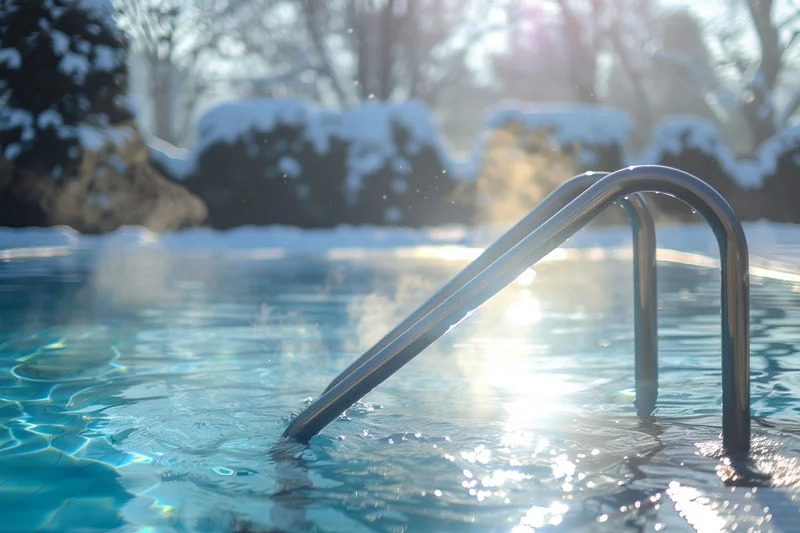Winterize pool
Winterizing your pool is essential to protect it during the colder months. Proper winterization helps prevent damage caused by freezing temperatures and ensures that your pool is ready for use when spring arrives. Here are the steps to effectively winterize your pool:
Winterizing Your Pool: Essential Steps:
- Remove Pool Accessories:
Take out skimmer baskets, cleaners, ladders, steps, and solar blankets.
Hose off any dirt and algae, let them dry, and store them safely for the winter.
- Deep Clean the Pool:
Remove leaves, silt, and other debris from the pool.
A clean pool makes water chemistry balancing easier and prevents mold and algae growth.
Use skim nets to clean the surface and a pool vacuum for debris at the bottom. Thoroughly brush the pool’s floor and sides.

- Adjust Water Chemistry:
Test water chemistry a week before closing the pool.
Ensure:
Alkalinity: 80–150 ppm
pH level: 7.2–7.6
Calcium hardness: 175–225 ppm
Chlorine level: 1–3 ppm
Balance alkalinity before adjusting pH levels.
- Lower the Water Level:
If not using a skimmer cover and in a freezing area, lower the water level. For mesh covers, lower water about a foot below the skimmer. For solid covers, lower it half a foot below.
- Drain and Store Equipment:
Drain all equipment to prevent water expansion and damage during freezing temperatures. Clear water from pool lines using a blower and plug them with expansion plugs. Consider adding pool antifreeze for extra pipe protection.
- Cover the Pool:
Use a pool cover to shield against debris and harsh weather. If you need assistance, our skilled service team is available to winterize your pool effectively.
10 pool maintenance tips blog:
10 pool maintenance tips blog:
Proper pool maintenance is crucial for keeping your pool clean, safe, and enjoyable. Here are ten essential pool maintenance tips to help you maintain a sparkling pool:
Skim Debris and Clean Out Baskets:
Regularly skim the pool surface using a hand skimmer or leaf skimmer to remove leaves, bugs, and other debris. Clean out strainer baskets attached to the pool to improve circulation and reduce chlorine demands.
Regularly skim the pool surface using a hand skimmer or leaf skimmer to remove leaves, bugs, and other debris. Clean out strainer baskets attached to the pool to improve circulation and reduce chlorine demands.
Vacuum the Pool and Brush Walls and Tile:
Vacuum your pool weekly to keep the water clear and minimize chemical usage. Brush the walls and tile to prevent algae growth and calcium deposits.
Vacuum your pool weekly to keep the water clear and minimize chemical usage. Brush the walls and tile to prevent algae growth and calcium deposits.
Maintain Water Chemistry:
Test water chemistry weekly. Balance alkalinity, pH levels, calcium hardness, and chlorine levels. Adjust as needed to ensure optimal water quality.
Lower the Water Level (if necessary):
Lower the water level below the skimmer if you’re not using a cover and live in a freezing area.
Lower the water level below the skimmer if you’re not using a cover and live in a freezing area.
Drain and Store Equipment:
Drain pool equipment to prevent damage during freezing temperatures. Clear water from pool lines and consider adding pool antifreeze.
Cover the Pool:
Use a pool cover to shield against debris and harsh weather.
Use a pool cover to shield against debris and harsh weather.
Professionally Service the Heater:
Regularly maintain and service your pool heater to ensure efficient operation.
Regularly maintain and service your pool heater to ensure efficient operation.
Clean the Pool Filter:
Check and clean the pool filter at least twice a year. Replace the filter every 1 or 2 years.
Check and clean the pool filter at least twice a year. Replace the filter every 1 or 2 years.
Superchlorinate Water:
Shock the pool periodically to eliminate contaminants and maintain water clarity.
Shock the pool periodically to eliminate contaminants and maintain water clarity.
Winterize Your Pool:
Properly close your pool for the winter season. Follow guidelines based on your location and climate.
Properly close your pool for the winter season. Follow guidelines based on your location and climate.
Planning your outdoor living space is an exciting endeavor. Whether you’re envisioning a cozy patio, a lush garden, or a multifunctional backyard, thoughtful design ensures you’ll create a space you’ll love. Here are 12 essential tips to guide you:
Purpose: Consider how you’ll use the outdoor space. Are you hosting dinner parties, BBQs, or seeking a quiet retreat? Factor in the number of guests and any specific needs (kid- or pet-friendly areas).
Layout: Design the outdoor space thoughtfully, just like planning a house floor plan. Ensure logical connections to the indoors, such as placing the dining area near the kitchen.
Surroundings: Embrace your property’s views. Arrange seating areas to enjoy sunrises, sunsets, or other scenic vistas. Use hedges or screens to block unsightly views.
Exposure: The direction your space faces matters. North- and east-facing areas may be unusable in winter but cooler in summer.
Wind Patterns: Observe prevailing wind directions and times. Avoid designing seating areas in wind tunnels.
Comfort: Provide shade for sunny spaces. Umbrellas, pergolas, or trees offer relief from the heat and shelter from passing showers.
Materials: Choose durable, weather-resistant materials for furniture, flooring, and structures.
Plants and Greenery: Integrate plants, flowers, and trees. They enhance aesthetics, provide privacy, and attract wildlife.
Water Features: Consider adding a fountain, pond, or small waterfall for soothing sounds and visual appeal.
Furniture Arrangement: Arrange furniture for comfort and flow. Create cozy conversation areas and dining spaces.
Fire and Heat: Incorporate a fire pit, outdoor fireplace, or patio heater for warmth during cooler evenings.
Remember, your outdoor living space should reflect your lifestyle and preferences. Enjoy creating your ideal oasis!
